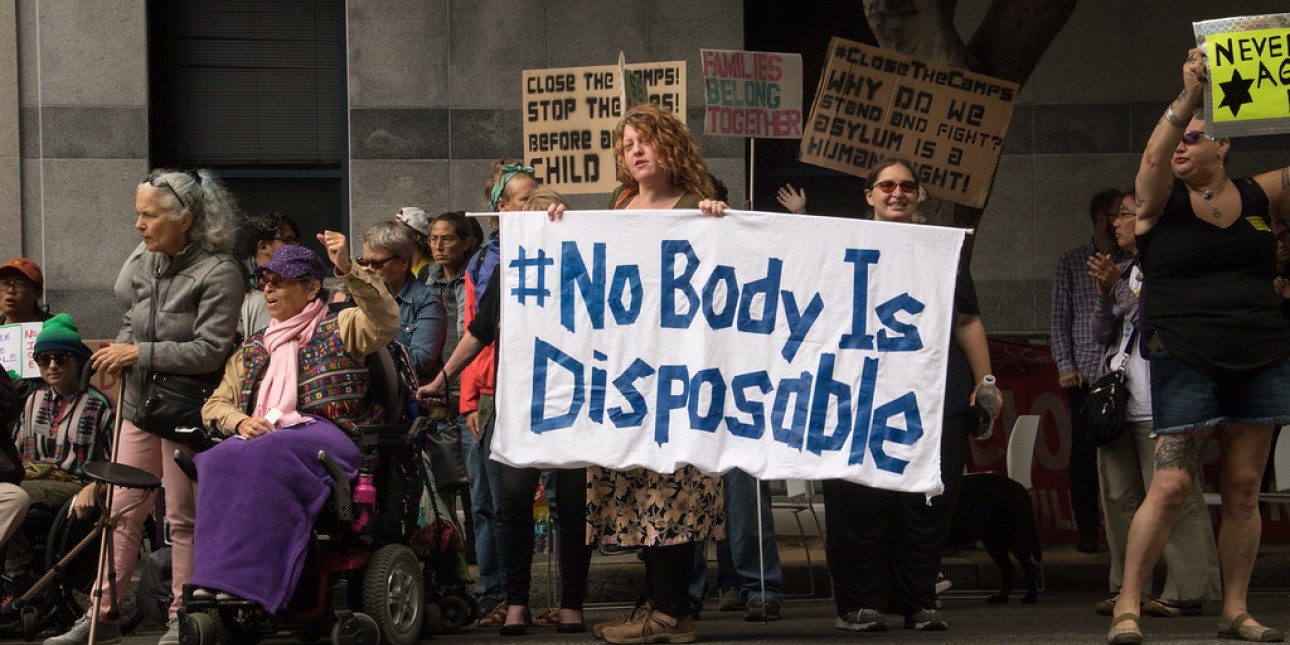Disability Rights, Pride, and Justice in the Youth Services Field

This July marks the 32nd anniversary of the Americans with Disabilities Act, a piece of civil rights legislation prohibiting discrimination based on disability. The ADA, however, never would have been passed if it hadn’t been for the advocacy and activism of disabled individuals, who fought hard through legislative avenues to form the disability rights movement. The movement came to heightened public attention in 1977 with the 504 sit-ins, where disabled individuals with the support of the Black Panther Party, occupied the Health, Education, and Welfare Office (HEW) in San Francisco for 25 days to demand the signing of the regulations of section 504 of the rehabilitation act.
The ADA marked the beginning of an era where public spaces were required to meet minimum standards for accessibility so that disabled people were no longer barred from public spaces. Despite the ADA, a rights-based framework for achieving equality is limited. And of course, the ADA never really prevented discrimination, especially for those most marginalized, who did not have the resources to pursue legal avenues to sue.
Disability Justice, on the other hand, is a movement originated by disabled and queer people of color. It emphasizes principles such as intersectionality, leadership from the most impacted, collective access and liberation, and cross-disability solidarity. Disability justice honors the insights of those who have historically been excluded from a disability rights framework by centering the knowledge that disabled people have used to survive outside of capitalist state systems.
In practice, disability justice shifts away from a limited rights-based framework that leans into values such as disabled people’s “independence” as a way to achieve liberation. Instead, it honors that none of us, disabled or not, are truly independent. Instead, we are interdependent – we rely on each other to survive, and our communities can only be sustainable if we acknowledge and uplift our relationships and connections.
About disability pride month, the Disability Justice Initiative at the Center for American Progress states, “Disability Pride Month is more than just representation and inclusion. It’s about building and uplifting a community, taking action, and building networks. Now more than ever, we need to support the most vulnerable in the community.”
What disabled pride means for me, with disability justice in mind, is acknowledging the very violent histories of marginalization that have cast disabled people as unworthy, pitiful, and undeserving of care. Disabled pride recognizes that my body carries with it those histories and legacies. I claim disabled pride not just because I live with disabling chronic illnesses, but also because it allows me to build community and form a political identity.
In regards to youth homelessness, a disability justice framework is imperative for assuring that service providers are leaning away from very common but ableist models of encouraging young people’s “self-sufficiency” and “independence” as a path out of homelessness. Instead, service providers should work from an anti-ableist framework that honors strong relationships and connections as essential to long-term stability and safety.
For this reason, incorporating anti-ableist and disability justice frameworks into the youth services field is essential so that providers do not fall into the trap of encouraging young people to survive through hyper-independence. Ultimately encouraging hyper-independence only leads to shame and further stigmatization when a young person continues to struggle.
Steps to take to include disability justice and disabled people into program models include collecting data on disabled individuals served, building trust with young people so that they feel safe to disclose disability if they would like to, and ensuring resources meet standards for accessibility. It also means that Runaway and Homeless Youth (RHY) service providers need to engage in cultural competency training that includes disabled identity, hire disabled individuals ( especially disabled and queer people of color) to lead and organize trainings, build strong partnerships with local disability service providers and organizations, and become familiar with the correct language used by the disabled community.
As a disabled individual myself, I know from my lived experience just how important all of these steps are. My experiences with youth homelessness were a direct result of systemic ableism. Practices such as institutionalization uprooted me from my home and my support network, and labeled me, instead of an unsafe living environment, as the problem.
Knowing that disability was something I was supposed to be ashamed of has made it all the more important to claim pride in the ways in which I identify with the disabled community, even if having pride “for” the very real and difficult aspects of navigating life with a disability is understandably more conflicted and difficult.
This July, I am honoring the complexities of the relationships between disability rights, pride, and justice, and taking extra care to connect with and share appreciation and love within my community.
Check out these resources below on disability rights, justice, and language used within the community:
- 10 Principles of Disability Justice
- Demystifying Disability Language
- Why People with Disabilities often Prefer to be Called Disabled over Differently Abled
- #NoBodyIsDisposable Campaign - Disability Justice and the COVID-19 Pandemic
- Short History of the 504 Sit-in
Rachel (she/her) is a student at UW-Madison and a member of the Dane County Youth Action Board. She is a formerly homeless, runaway youth and a member of the disability and LGBTQ+ communities. As someone who experienced the harms of repeated institutionalization growing up, she is a strong advocate for community-based care, accountability measures, disability rights, and justice. She is an artist and writer and is passionate about using her skills to advocate for a world where all young people have the right to autonomy, safety, care, and freedom from harm.


